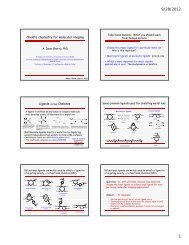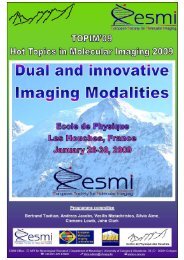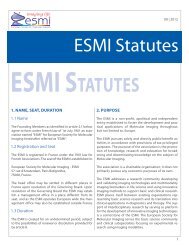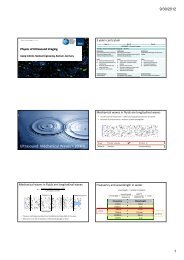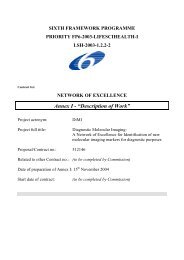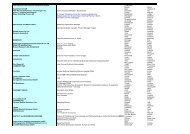5th EuropEan MolEcular IMagIng MEEtIng - ESMI
5th EuropEan MolEcular IMagIng MEEtIng - ESMI
5th EuropEan MolEcular IMagIng MEEtIng - ESMI
Create successful ePaper yourself
Turn your PDF publications into a flip-book with our unique Google optimized e-Paper software.
<strong>5th</strong> <strong>EuropEan</strong> <strong>MolEcular</strong> <strong>IMagIng</strong> <strong>MEEtIng</strong> – EMIM2010<br />
Serotonergic neurotransmission in early Alzheimer’s disease<br />
Hasselbalch S. G. (1) , Marner L. (1) , Madsen K. (1) , Lehel S. (1) , Barré W. (1) , Knudsen G. M. (1) .<br />
(1) Copenhagen University, Denmark<br />
sgh@nru.dk<br />
Introduction: Post mortem studies suggest involvement<br />
of the serotonin system in Alzheimer’s disease<br />
(AD) and serotonin 2A (5-HT2A) receptors are<br />
globally reduced early in the course of the disease<br />
(1). However, few studies have investigated other<br />
aspects of the serotonergic system, including presynaptic<br />
markers (serotonin transporters, SERT) as<br />
a measure of serotonergic degeneration (2). Further,<br />
recent evidence points to a disease-modifying effect<br />
of 5-HT4 agonism through a decrease in beta-amyloid<br />
load (3). Therefore, we have investigated SERT<br />
and 5-HT4 in early and compared these measures to<br />
the reduction in 5-HT2A receptors.<br />
Methods: For the SERT/5-HT2A comparison, we<br />
included 12 patients (mean age 73.7 ±7.6 years, 8<br />
males) with AD (average MMSE of 24, range 19-26)<br />
and 11 healthy age-matched subjects (mean age 72.5<br />
±6.8 years, 6 males). Subjects were investigated with<br />
a 90 min dynamic [11C]DASB-PET recording to<br />
measure SERT (4) and a 40 min steady-state [18F]<br />
altanserin-PET recording to measure 5-HT2A receptors<br />
(5). In a separate study of 5-HT4 receptors,<br />
the novel radioligand [11C]SB207145 was used in<br />
twelve healthy individuals (mean age 67.2 y, 6 males)<br />
and eleven newly diagnosed AD patients (mean age<br />
70.6 y, 6 males, mean MMSE 24, range 19-27) using<br />
the simplified reference tissue model. Volumes of<br />
interest (VOIs) were delineated automatically on coregistered<br />
3T MRIs, and partial volume correction<br />
was applied to correct for differences in atrophy.<br />
Results: The 5-HT2A receptors were markedly reduced<br />
(25-66%) in AD patients in all regions but<br />
the striatum. Inc contrast, we found a reduction of<br />
SERT binding by 34% (p=0.0003) in the hippocampus,<br />
while most other regions were unaffected.<br />
Midbrain showed no change in binding (p=0.30).<br />
No statistically significant differences in 5-HT4 receptor<br />
binding between healthy individuals and AD patients<br />
were found in any of the included brain regions:<br />
Hippocampus (p = 0.55), posterior cingulate gyrus<br />
(p = 0.22), amygdala (p = 0.77), parietal cortex (p =<br />
0.44), temporal cortex (p = 0.74) and prefrontal cortex<br />
(p = 0.43).<br />
Conclusions: We showed a marked decrease of<br />
5-HT2A binding in patients with mild AD, consistent<br />
with previous findings in MCI (1). The SERT<br />
binding was unaffected by the disease in almost all<br />
cortical regions and in midbrain, suggesting that<br />
the serotonergic innervations and the neuron bodies<br />
in dorsal nucleus raphe are intact, at least early<br />
in the disease. We interpret the SERT reduction in<br />
hippocampus in patients as a decreased serotonergic<br />
innervation, which could be secondary to the neuronal<br />
degeneration taking place in hippocampus of<br />
AD patients. The marked reduction in 5-HT2A may<br />
be related to beta-amyloid accumulation. In contrast<br />
to the 5-HT2A receptor subtype, the 5-HT4 receptor<br />
levels seemed to be unaffected in AD. However,<br />
5-HT4 binding in relation to cognitive function,<br />
neuropsychiatric symptoms and beta-amyloid load<br />
should be further investigated.<br />
Acknowledgement: Supported by The Lundbeck<br />
Foundation, Rigshospitalet, and the Danish Medical<br />
Research Council. The John and Birthe Meyer Foundation<br />
is gratefully acknowledged for the donation<br />
of the Cyclotron and PET-scanner. These studies<br />
were funded in part by the EC - FP6-project DiMI,<br />
LSHB-CT-2005-512146.<br />
References:<br />
1. S. G. Hasselbalch et al., Neurobiol. Aging. 29, 1830<br />
(2008).<br />
2. K. Nielsen et al., Synapse. 59, 270 (2006).<br />
3. S.J. Robert, et al., Neurodegener Dis 5(3-4):163 (2008).<br />
4. M. Ichise et al., J Cereb. Blood Flow Metab. 23, 1096<br />
(2003). L. H. Pinborg et al., J. Cereb. Blood Flow Metab.<br />
23, 985 (2003).<br />
<strong>EuropEan</strong> SocIEty for <strong>MolEcular</strong> <strong>IMagIng</strong> – <strong>ESMI</strong><br />
day1<br />
Parallel Session 2: NEUROSCIENCE I



